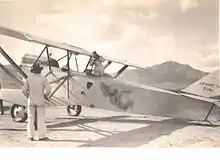Azcárate O-E-1
The Azcárate O-E-1 was a reconnaissance-bomber aircraft developed in Mexico in the late 1920s. It was designed by General Brigadier Juan Francisco Azcárate and built at the TNCA workshops near Mexico City. A trainer version, the Azcárate E-1 (for Escuela) was also built. It was a sesquiplane of conventional configuration with tailskid undercarriage, and seating the crew in tandem, open cockpits. The types are sometimes collectively referred to simply as the "Azcárate sesquiplane" (sesquiplano in Spanish).
| O-E-1 | |
|---|---|
 | |
| E-1 | |
| Role | Reconnaissance bomber |
| Manufacturer | TNCA |
| Designer | Juan Azcárate |
| First flight | 1928 |
| Number built | 1 |

On 30 September 1928, pilot Gustavo León and Subteniente and mechanic Ricardo González set out on an aerial circumnavigation of Mexico in an O-E-1. Conducted in 58 legs, they completed their 10,986 km (6,826 mi) flight on 18 December.
Specifications (E-1)
General characteristics
- Crew: two, pilot and instructor
- Length: 6.8 m (22 ft 4 in)
- Wingspan: 10.50 m (34 ft 6 in)
- Height: 2.57 m (8 ft 3 in)
- Wing area: 23.5 m2 (253 sq ft)
- Empty weight: 666 kg (1,465 lb)
- Powerplant: 1 × Wright J-5 radial engine , 112 kW (150 hp)
Performance
- Maximum speed: 165 km/h (103 mph, 90 kn)
- Endurance: 4 hours
- Service ceiling: 4,500 m (14,760 ft)
References
| Wikimedia Commons has media related to Azcárate O-E-1. |
- Taylor, Michael J. H. (1989). Jane's Encyclopedia of Aviation. London: Studio Editions. p. 109.
See also